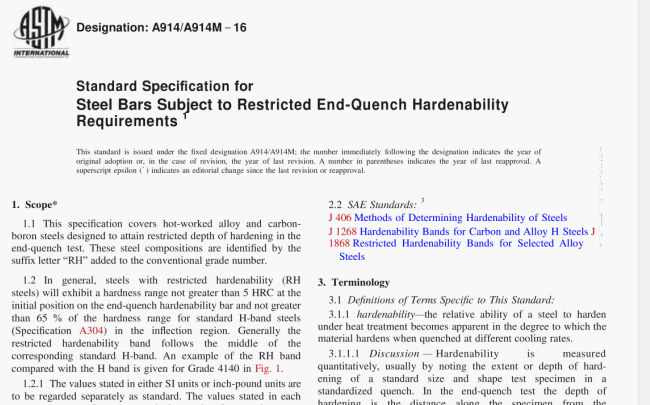ASTM A914:16 pdf download.Standard Specification for Steel Bars Subject to Restricted End-Quench Hardenability Requirements.
4.3 Band limits are shown graphically and as tabulations in Figs. 2-23, inclusive. For specification purposes, one must use tabulated values of Rockwell hardness (HRC) as a function of distance from the quenched end of the hardenahility bar, either in inch-pound units (sixteenths of an inch) or in SI units (millimetres). Values below 20 1-IRC are not specified because such values are not accurate.
4.3.1 Band limits shown graphically are so depicted for convenience in estimating the hardness values at various intermediate locations on the end quench test bar for quick comparisons of the various RH grades. The values of “Approximate Diameter of Rounds with Same As-Quenched Hardness” shown above each Ru-band, were selected from ranges appearing in Fig. 7 of SAE J 406. The RH-bands are presented graphically, with distances from the quenched end in both inch-pound units and also SI units.
4.4 For specification purposes. RH-band steels shall exhibit hardness within the minimum and maximum HRC range specified at the J I (J 1 .5-mm) position and shall meet one additional minimum and one additional maximum value. In this specification, the two additional hardness values shall represent the approximate hardness for 50 % martensite for the minimum and maximum specified carbon content, respectively (except where hardenability is too high; then the two additional hardness control values shall be five HRC points below the maximum hardness value specified at the ii (J1.5-mm) position).
4.4.1 In general, these points define the critical locations of the Jominy hardenability band for purposes of characterizing heat treatment response. The four specification points are circled in the tables of hardness versus Jominy distance and on the RH- bands. For all other Jominy positions, a tolerance of two points HRC is permitted for a maximum consecutive
3A6-in. or 5-mm Jominy distance on the restricted hardenahility band.
4.4.2 For example, referring to Fig. 9, a hardenability test bar of a steel meeting the requirements for 4140RH must exhibit a hardness at Ji not less than 54 HRC, nor more than 59 HRC. At J 12, the test bar must exhibit hardness not less than 43 HRC, but the maximum hardness can be as high as 52 HRC (or even 54 HRC lithe region of the test bar is chosen as the exception). At J20, the bar must exhibit hardness not greater than 47 HRC, but the minimum hardness can he as low as 37 HRC (or as low as 35 HRC if this region of the test bar is chosen as the exception).
4.4.3 A similar example, referring to Fig. 9, for 4140RH with distances from the quenched end in millimetres would limit hardness at J 1 .5 mm to not less than 54 HRC nor more than 59 HRC. At J20 mm, the test bar must exhibit hardness not less than 42 HRC. At J30 mm, the test bar must exhibit hardness not greater than 48 HRC.
5. Manufacture
5.1 Melting Practice—The steel shall be made by one or more of the following primary processes: basic-oxygen or electric furnace. The primary melting may incorporate separate degassing or ladle refining and may be followed by secondary melting using electroslag remelting or vacuum are remelting.
ASTM A914:16 pdf download
